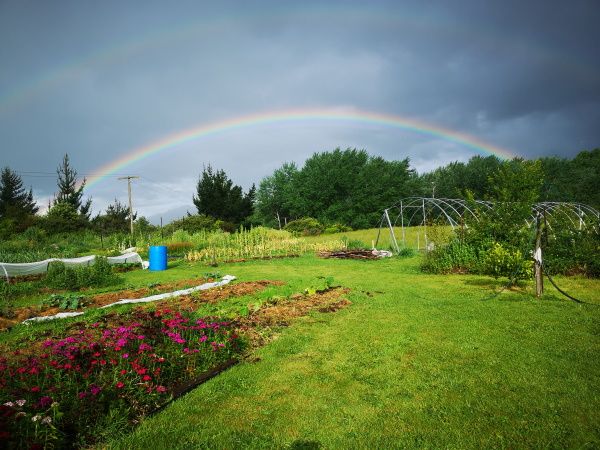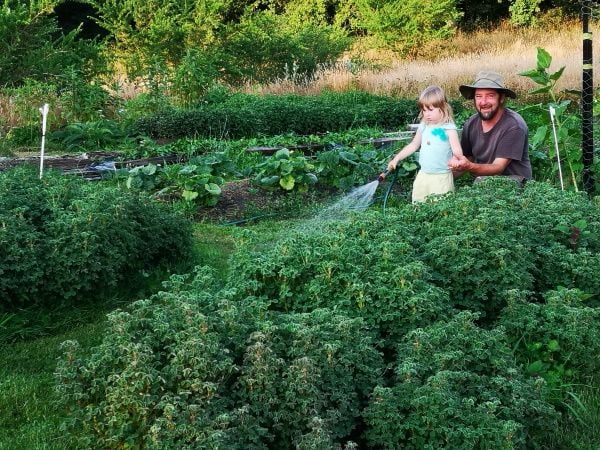🌱 Garlic and Your Winter Garden 🌱
Posted on
Dear Gardeners and Friends,
Happy New Year! At long last, after our much deserved computer holiday, we are back in the office processing orders and answering emails. We know many of you have been waiting for our seed garlic to come available on our website, and the moment is now. We are able to offer for sale our early varieties and the elephant garlic, we successfully grew and have gotten a decent crop of all our main crop cultivars, although the amount we grew is still too small for commercial sale. We hope to have Rocambole, Henry’s Soft Top and Takahue available again in the future, but the Early Pearl and Early Purple specifically are holding their own better with the rust. We had our best year with garlic in general, since rust hit us for the first time back in 2015. We have learned a lot along the way, and part of this learning process was pulling back on the quantity of garlic we grow, while we experiment to see if we can still get a crop worth selling for seed and eating. Fortunately, each year is better than the last, so something must be working!
So many folks, including commercial growers both organic and conventional have gotten out of garlic since the rust arrived. It is so very disheartening to put so much energy and effort into growing any crop and then to have nothing come of it. I think growers around the country have struggled especially with garlic failures, because for so many years it was such an easy crop to grow! Those days seem to be over, but we are finding with slightly different planting times and methods we are still seeing good results, worth the work. Here are our insights thus far into garlic growing with rust. I will repeat past insights as well as new ones from this season.
What we know about Garlic Rust:
- Rust does NOT transfer to the seed, thankfully you can still plant cloves from plants that were affected with rust.
- Rust species, Puccinia allii, lives on LIVE allium (onion, leek, garlic, elephant garlic, chive, bunching onion, and spring onion) plant matter. If you grow other alliums in the garden particularly leeks as their growing season is the other half of the year from garlic, you may find the spores will remain in your garden and re-inoculate your crop. Fortunately, once the plant dies, so do the spores of the rust fungus. My research initially led me to believe that only this specific species effects alliums, but I have seen in our garden rust spread from non-allium plants such as grass to our garlic. I now keep an eye out in spring for any rust on any plant and if it appears I try to remove the plant on a calm, no wind moment, and bag it to be taken out of the garden.
- Rust is a fungal spore that spreads on the WIND especially in moist environments. The longer the leaves and any surrounding weeds stay wet the more that the rust will spread. Wet springs bring more rust then dry ones. We have successfully for the last two seasons planted our garlic up wind (from our prevailing wind in spring) from leeks and we plant our main crop garlic up wind from our early garlics. This technique is very effective at limiting the spread of the spores.
- Garlic rust has two types of spores, orange and black. The black spores are the ones that hunker down and wait for the right climatic conditions and then start to produce the orange spores. These spread all over the leaves and significantly impact the growth of the crop by blocking photosynthesis and stressing the plant overall.
- Plant spacing and placement in the garden is very important. Traditionally, we have planted garlic as close to 10-15cm apart in a biointensive grid pattern. Those days a long gone, as this means all their leaves are touching, and the rust can then spread like wildfire. We now plant garlic in rows at 25cm spacing, and the cloves in the rows also at 25cm spacing. We use mulch (grass clippings or straw) and weed regularly to allow for as much air movement as possible so plants can dry faster. We also plant each garlic bed spread out across the whole garden with no two beds next to each other. In the past, we would have a garlic patch, this meant that if rust presented, it would soon spread to the whole plot. With the spreading out technique, if one bed gets rust, other beds don’t. In the home garden even if you are only planting a small number of cloves I would recommend spreading them out so you don’t have all your plants together.
- Early planting is probably the most effective thing we have done to date. Planting your early and main crop garlics in March/April gives the plants a head start on growth. By November when the spores seem to get out of hand, the crop is more developed and better able to size up, regardless of rust.
- Variety choice is important. We have consistently found our early garlics (Early Pearl and Early Purple) to be less affected by the rust than the main crop varieties. Elephant Garlic, is actually a leek and neither leeks or elephant garlic are affected by the rust, so choose wisely when planting. A failsafe choice seems to be elephant garlic.
Practical steps you can take in your garden:
- Prevention is key. Once you have rust it is impossible to get rid of in an organic system. Focus on healthy soil. We know that healthy soil leads to healthy plants, and this is your best defense from any pest or disease. We use our home made compost, micronized lime and liquid seaweed at planting time. We also apply Enviromental Fertilisers foliar sprays throughout the season.
- Do not overhead irrigate. Moisture on leaves is the danger time when rust spores multiply and spread.
- Plant your garlic up wind from all other alliums. Space your garlic at least 20-30cm apart to allow for faster drying in the crop, as the spores will travel in the wet. Spread the garlic cloves out across the garden, not all in one place even if your planting is small.
- Clear out all other allium plant material at least two weeks prior to garlic leaf emergence. And check the garden for any plant with rust present, remove any affected plants regardless if they are an allium or not. If this is not possible, keep a very close eye on the other crops and make sure they are rust free.
- Seed selection, we are selecting the bulbs that held up the best to the rust. If you are holding back seed from your own stock, pick the biggest bulbs and the plants that had the least rust on them. This is good practice whether you had rust or not.
- Planting on the day of Moon Opposition to Saturn has been recommended by Rachel Pomeroy (Organic NZ magazines Moon Calendar author) as an ideal time to work with the Biodynamic calendar to help build strength against rust. Moon Opposition to Saturn is a great all round seed sowing day as the Moon represents fertility and germination and Saturn represents form and strong structure.
Something I became aware of a couple years back, is that there are some avid garlic growers around the country growing what is technically called True Garlic Seed or TGS. We commonly refer to cloves selected for planting as garlic seed, in truth this is clone reproduction and there is no change in the variety through this method other than local adaptation. If you want to breed new varieties and develop resistance to rust through proper plant selection and breeding, then TGS is what to use. This type of garlic growing is even more a labour of love, as it is very time consuming, and difficult. Here is an interesting article on the topic to find out more. I hope that if these NZ growers are successful, one day we will be able to offer cloves from their new rust resistant variety(ies). This will take a while (years) so don’t hold your breath! I will be sure to keep you posted.
Garden Tour & Afternoon Tea - February 29th, 2020. Please see our website for more details. We are excited to see some of you here and show you around our seed gardens to talk about our garden design and what techniques we use to grow healthy plants, vegetables and seeds.
Things to Sow in the Garden Now:
January and February are the months to sow seeds for your winter garden! I know it is hard to believe that we need to be thinking about our winter veges now, but if you want broccoli in June, so now! Here is what we are planting:
Broccoli De Cicco, Kale Pohara and Red Russian, Silverbeet Fordhook Giant, Spinach Bloomsdale, Orach Red, Coriander, Salad Burnet and Carrot White Belgium. We sow lettuces each month to keep in constant supply, now we focus on the cooler season varieties like Winter, Lollo Rossa, Red Salad Bowl, Tree, and Speckled. Now is also a good time to get Asian greens like Mizuna, and Tat Soi in, as well as, Rocket and Wild Arugala to keep in supply. Remember with all brassicas they are susceptible to the white cabbage butterfly, so to protect from this, we recommend covering your crops while they get established with fine frost cloth, or remove the caterpillars by hand. Of course, there are organic sprays available, but we do not use these. We prefer instead to create a barrier so the butterflies cannot lay their eggs. Problem solved.
Don’t forget about flowers for the winter garden! Calendulas, Poppies, Lupins and Sweet Peas are frost hardy and beautiful!
We often follow Rachel Pomeroy's biodynamic calendar in Organic NZ magazine for inspiration on sowing times.
Our Website is the best place to find the most up to date information on what we have available at all times during the year.
We encourage orders through this medium, but of course we will still accept orders via email from our Catalogue or via the post using our printed order form.
And here is our Order Form PDF or Order Form Excel
Email orders from the catalogue to: sethasseeds@outlook.com
Or post order forms to: Setha's Seeds PO Box 60, Tutira 4181
And a reminder that selections of our seeds are also available from Cornucopia Organics in Hastings and Edible Garden in Ashhurst, the Thames Organic Shop in Thames and Tim's Garden in Nelson.
Happy gardening,
Roddy, Setha and River Rose


